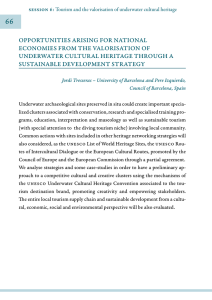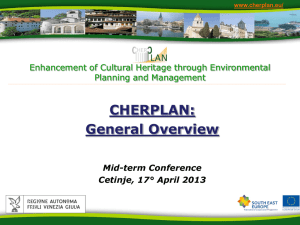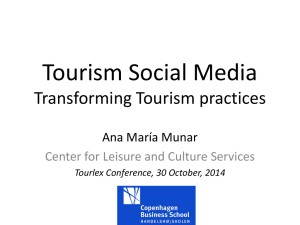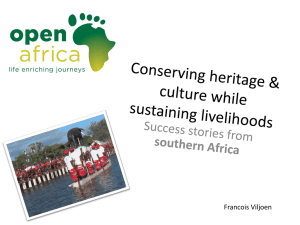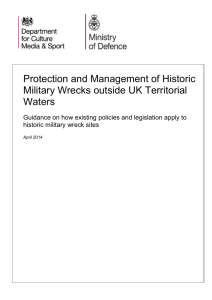Underwater Cultural Heritage and Sustainable Development
advertisement
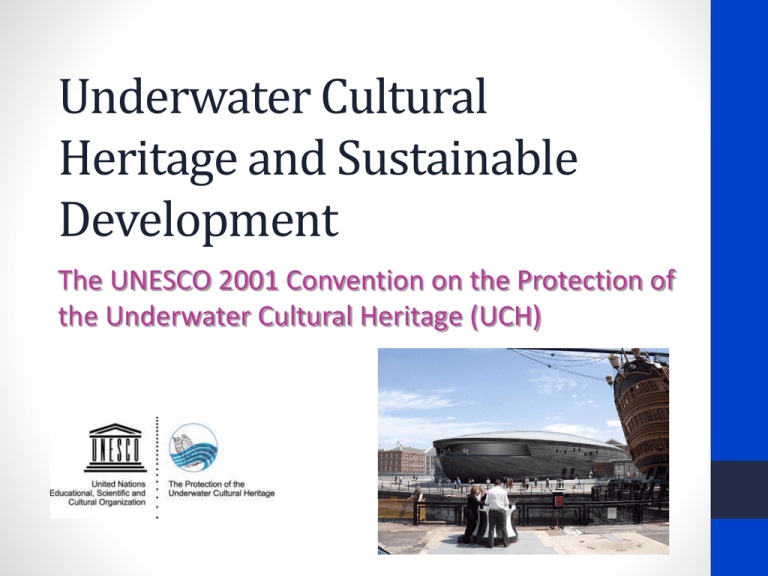
Underwater Cultural Heritage and Sustainable Development The UNESCO 2001 Convention on the Protection of the Underwater Cultural Heritage (UCH) Tourism and Culture • Tourism and culture are intimately connected; the latter provides an incentive for the former • 9.5% of global GDP comes from tourism • In developing States, tourism can account for up to 25% of GDP • Studies show that 37% of global tourism is related to culture and heritage • One study has shown that for every $1 that a visitor spends at a heritage site, they may spend up to $12 at surrounding businesses, such as hotels, restaurants, etc. Culture is Development • Sustainable tourism development must include the protection and promotion of cultural heritage • Underwater cultural heritage represents a unique form of cultural heritage that distinguishes those areas that promote it from other destinations © Larue, photographing a shipwreck. Underwater Cultural Heritage Tourism • Underwater cultural heritage is especially important for coastal and island States, many of which have established maritime and coastal tourism industries • For example, the Vasa Museum in Stockholm brings an estimated $300 Million each year to the city • Museums featuring underwater cultural heritage present a unique and original experience for tourists © A. Ohlson\UNESCO Vasa Museum, Stockholm Diving Tourism • Dive trails, guided tours and protected marine areas can attract significant numbers of tourists • For example, from 2002-2005, the Yongala Wreck in Australia attracted nearly 8,000 divers per year • There are an estimated 6 Million active divers in the world • The number of active divers in increasing; The number of divers has increased by an average of 8.5% annually since 1970; the number of divers in California grew by nearly 13.5% annually between 2005 and 2013 • Dive tourists spend more time and money at their destinations than others © Xploredive\UNESCO Plan of SS Yongala, Australia Untapped Potential • Despite the potential of underwater cultural heritage for sustainable tourism development, many coastal and island States have not attempted to utilize their available heritage • A recent UNESCO study in the Maldives shows that the major focus remains beach tourism • States that rely heavily on tourism must diversify their offerings to continue to grow • Underwater heritage presents a unique opportunity to diversify • An area not known for its culture can be shown to have a rich cultural legacy underwater • The pairing of land and underwater sites in cultural routes, museums or tours can promote development and increase tourism The Challenges • Underwater archaeologists are needed to discover and research sites • Many sites are not under any legal or operational protection, they are open to pillaging by treasure-hunters, who often know the sites better than local law-enforcement • Little effort has so far been made to make sites accessible • Many sites are not accessible to tourists, due to depth, preservation, or dangers The Dangers of Treasure Hunting • The temptation of recovering precious metals and other treasures from wrecks can be great • But, such exploitation is not sustainable • States that allow treasure hunting have lost billions in recent decades (loss of heritage, legal fights, administrative hassles) • Development focused on preservation and tourism is sustainable – Treasure hunting is not “Florida’s policy towards its underwater antiquities has cost the State millions… If Florida had … invested USD 10 million in two great maritime museums back in the 1960s, instead of giving leases to salvors, the State would be nearly half a billion dollars richer each year…”1 (Peter Throckmorton) UNESCO Contact: Ulrike Guérin, UNESCO Convention on the Protection of the Underwater Cultural Heritage (2001) 7, place de Fontenoy, 75352 Paris 07 SP France Tel: + 33 1 45 68 44 06 Email: u.guerin@unesco.org Web: www.unesco.org/en/underwater-cultural-heritage
